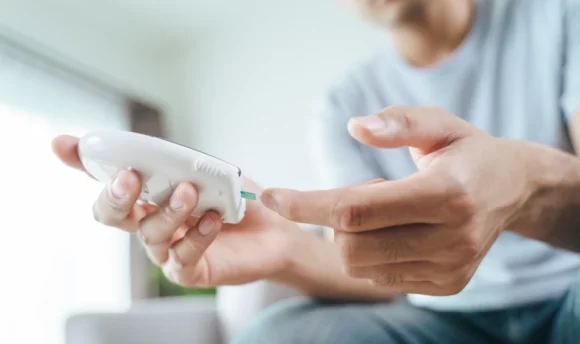Diabetes Headache: What Is the Real Cause of It?
Getting headaches can be annoying when you don’t understand the cause of it. People who suffer from diabetes may experience this head pain more often, but why does that happen exactly? We explain diabetes headaches and how blood sugar might affect that.

A headache can be extremely annoying to deal with, especially when you don’t know the underlying reason. Those who have diabetes usually get headaches due to insulin resistance or low blood glucose, but why is that? And how can you prevent them from happening?
People may experience moderate to severe headaches, depending on their blood glucose levels. Over-the-counter medication can help relieve symptoms, or even drinking plenty of water, as most experts say. If you get regular headaches, it might be worth learning more about them.
You might be asking – can diabetes trigger head pain? What is the connection between diabetes and headaches? Keep reading our guide to learn the cause of challenging head pain.
In this article, you’ll discover how diabetes can cause headaches.
Diabetes Headaches – Understanding the Cause
Headaches can indicate that you have too high or low blood sugar levels.
Not everyone will get them, but people with diabetes often experience this annoying head pain. Diabetic headaches link to hyperglycemia – a condition that triggers high blood glucose and makes you feel weak. Hypoglycemia is the other condition that signals low blood glucose.
You might feel average or intense pain that feels like “uncomfortable pressure” on the skull. This is due to the fluctuating hormones that control pain chemicals in your brain. Diabetes-related headaches will only occur if your blood glucose is over 200 milligrams per deciliter (mg/dL).
Other signs of hyperglycemia include excessive sweating, nausea, weakness, intense thirst, anxiety, shakiness, and irritability. Speak to a doctor if you suffer from most of these symptoms. You’ll receive over-the-counter medication that can help battle frequent symptoms.
Are Headaches a Sign of Diabetes?
Yes, headaches can be a sign of diabetes. You’ll need to experience other symptoms to determine if you really have this condition. Speak to a medical professional if you need to pee often, get very thirsty, have blurry vision, lose weight randomly, and feel weak.
Not all headaches instantly point to diabetes, but other unusual physical symptoms can indicate an insulin-related disease. If you just get headaches alone, there might be another underlying cause. Some people don’t realize they’re dehydrated and may experience head pain every day.
Try drinking plenty of water and get regular exercise to combat headaches. Some common reasons for head pain include migraines, hormones, constipation, skipped meals, and sleep disruption. A doctor can tell you whether diabetes is the trigger for your head discomfort.
Just be aware that primary headaches don’t relate to conditions or diseases. Brain overactivity might be the cause of this common head pain. Diabetes and headaches will often relate to secondary pain.
A secondary headache is what doctors reference when referring to diabetes-related symptoms that directly influence brain chemicals. This type of headache can also derive from hormones, medication, sinus pressure, allergies, caffeine overdose, and neck pain.
What Does a Blood Sugar Headache Feel Like?
A blood sugar headache might feel like a dull pain or throb around your temples. Many people experience nausea when their blood sugar levels fluctuate. You can talk to a doctor about what type of medication you need for that head pain.
Everyone will get different levels of pain depending on their pain tolerance. If you get dull throbs in your head, this might be a sign of low or high blood sugars. Some people report craving carbohydrates before headaches hit, which might be the body’s way of regulating blood sugar.
You might get migraine-type pain that triggers light sensitivity, dizziness, vomiting, and auras. Migraines can be excruciating and limit your physical capabilities. Always speak to a doctor if you get this type of pain, as they can prescribe relevant diabetes medication.
Can Low Blood Sugar Cause Headaches?
Yes, low blood sugar may cause general dull pain that lasts a few hours. This pain may occur with fatigue, confusion, increased heart rate, and irritability. Your blood sugar might drop if you skip important meals or don’t take the required medication.
Those who have a recent diagnosis of diabetes are probably still trying to find an effective routine. Regulating blood sugar levels isn’t a quick process that happens overnight. You might get frequent headaches after changing meals or taking new prescription medicine.
Hypoglycemia links to epinephrine and norepinephrine – two hormones that might constrict blood vessels in the brain. This is what leads to dull pain or discomfort that lingers. Doctors say that your blood sugar levels should never go below 70 milligrams per deciliter (mg/dL).
Can High Blood Sugar Cause Headaches?
A headache from high blood glucose usually takes a few days to develop. This pain may radiate in your temples and get worse if your blood sugar keeps rising. Hyperglycemia creates other physical symptoms like shortness of breath and frequent urination.
High blood sugar will only cause headaches if your level is above 126 mg/dL. Your insulin production can’t properly transfer glucose into the cells, leading to decreased energy. Running on low fuel may be the first sign of insomnia – a sleep disorder that can derive from diabetes.
Dehydration is another possible cause due to the excess glucose getting flushed out through urine. More toilet visits mean fewer natural fluids in your body. To combat this headache, men should drink at least 12 cups of water a day, and women should drink 9 cups.
How Do You Get Rid of Diabetic Headaches?
Getting your blood sugars under control is the first step to relieving painful headaches. You can do this by eating at regular times, tracking your food and drink, consuming lots of water, and taking insulin or diabetes pills that your doctor recommends.
Headaches can be challenging when you don’t understand the root problem. Hormones may disrupt chemicals in your brain and trigger that uncomfortable pain. One effective way to regulate diabetic symptoms is by exercising regularly – a simple walk or jog can offer relief.
The American Diabetes Association recommends keeping your blood sugars between 80 and 130 mg/dL. This can prevent headaches and common symptoms of diabetes. Doctors may also check your blood pressure to determine if you need extra medication.
You can also use the Klinio app to monitor the amount of sugar and cholesterol you need to consume. This should help you maintain blood sugars and prevent high blood pressure. You’ll have access to a categorized weekly shopping list that contains good foods for diabetes.
Klinio caters to people who have high blood pressure, cholesterol, anemia, irritable bowel syndrome, and chronic kidney disease. One simple app will give you comprehensive workouts that intercept high or low blood glucose symptoms.
FAQs
Those who have high blood sugar levels might experience tension headaches that radiate pain around the temples. Other common symptoms include nausea, vomiting, stomach pain, bad breath, fatigue, frequent urination, weight loss, and trouble concentrating.
One of the best drinks to lower blood sugar and prevent secondary headaches is unsweetened tea. You can drink chamomile tea three times per day to manage glycemic control. Tea naturally has plenty of antioxidants that treat headache pain and boost your overall health.
Yes, too much insulin in your body can cause secondary headaches. This may trigger hypoglycemia that activates pain signals in your brain. Going below the target range of 70 milligrams per deciliter (mg/dL) might seriously damage your long-term health.
A Word From Our Personal Trainer
Diabetes may give you plenty of uncomfortable symptoms, including persistent headaches that last a few days. People with type 2 diabetes may need to take medication to regulate high or low blood sugars. You can take a blood glucose test to determine your average levels.
Primary headaches aren’t usually a cause for concern since they only occur through overactivity or problems with pain structures in your brain. Doctors may recommend people seek professional medical help if secondary headaches persist from diabetes.
To eliminate these challenging headaches, drink lots of water and exercise regularly to push your sugar levels into the healthy range. Exercise reduces the risk of heart disease, migraines, high cholesterol, depression, strokes, and other diabetes symptoms.
Conclusion
So, is there a connection between diabetes and headaches?
You may experience a severe headache that shows early signs of disrupted glucose levels. Doctors can recommend medication to lower blood pressure and encourage fewer headaches.
Healthy eating, physical activity, regular meals, and consuming nutritious drinks may stop diabetes-related headaches or typical symptoms that follow this condition.
The Klinio app is another great option to use for managing diabetes. It contains 14,000+ recipes that keep you fit and healthy. You can swap ingredients to suit your personal preferences. Eating nutritious foods is very important for regulating your blood glucose levels.

















































 Select your language:
Select your language: 








